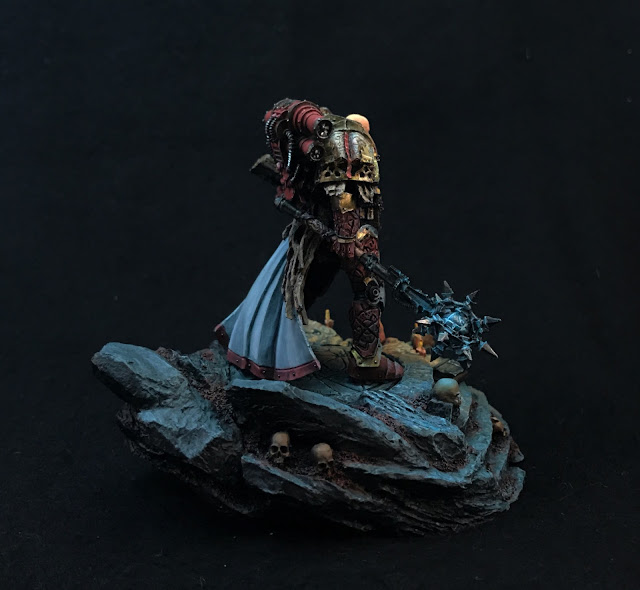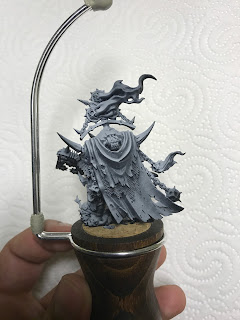A long journey
Mortarion definitely has been one of the most challenging projects I have done so far. There is the obvious crazy level of detail and the variety of materials. Also the pose adds its own level of difficulty to the painting. But I think it is the sheer size that is the most challenging aspect. Using the word "miniature" for this beast sounds almost like a joke. With "minis" like this just finishing it is an achievement in itself and it requires some proper discipline to do so. All in all it took about a month from start to finish with something like 5 evenings of painting every week.
In the end I am really happy with the result and a lot of the miniature went pretty much exactly as planned (which is a rare thing for my way of painting). My goal was first and foremost to find a way to paint him that is different from the "official" Game Workshop style and pushes the idea of him being a former Primarch of a Space Marine Legion - a little less demon, a lot less decay and filth but also a lot of age.
Painting becomes a lot easier if you try to imagine a small narrative to the scene you are trying to show. My version of Mortarion shows him while attacking one of the beautiful worlds of Ultramar - specifically a beautiful and lush garden. He has just arrived but his influence already starts to spread corruption and decay. The touch of his cloak will let the giant blossom under him rot away in seconds and we see the beginning of that in the miniature.
The base and it's beauty is one of the major contrasts against the old evil and decay that Mortarion stands for. To connect mini and base I decided for the idea of the beginning decay of the blossom. I had bought a number of these and decided between a rather perfect and round version and a slightly crumbled and shrunk version. I chose the latter to strengthen the idea of it being in the early stages of rotting away. The rest of the base was created to look beatiful and nice - a place you would want to visit.
Another important aspect for me was the age of Mortarion. He is way over 10.000 years old at this point and I wanted that to show that but not in the "classic" Nurgle rot way. The final idea came from his title: The Lord of Death.
The rather obvious association here is bones, old bones. I researched pictures of old and weathered bones online. There is essentially two: bones weatheres in the open like in a desert which are bright and almost white and the bones that have weathered in the ground. Those have a brown tone and they can be littered with tiny cracks. I cannot show the pictures I used for reference here as I do not own the rights to them.
I did a number of tests on Plague Marines and in the end came up with what you can see above: a brown to yellow tone with a hint of red in it. An important element to sell it are the micro cracks that go all over the surface. The whole armor has those and while they are hard to notice from a distance they give a nice detail when the mini is looked at more closely.
Beginning of a journey
The Mortarion kit is crazy and fantastic and also not easy to work with. Usually I like to build minis only so far that I can still easily reach all surfaces with the brush. This kit makes that difficult. I had to put most of the main body completely together to avoid major construction and correction work after the painting. This means that some of the surfaces are really hard to access. I left both hands, the wings and all attachments separated. As you can see above that is a huge number of parts.
Everything was primed in black and than I sprayed white mainly from above. I do this for two reasons. The white surfaces will show more vibrant colors later and even though the effect can be rather subtle after all the painting is done it is still visible. Even more importantly it is easier to actually see and study all the details of the miniature.
I usually spent a lot of time with the mini at that point to find and think about all the details it has.
The Armor
As mentioned above my goal was to give the armor the appeal of old dried and brittle bones. At the same time I wanted to avoid the classic Death Guard colors. Neither the 40k greens nor the 30k white appealed to me.So I decided for brown and yellow with a hint of red. Below you can see the first stage of the painting process on the leg. The base color is a more or less equal mix of P3 Rucksack Tan and Scale 75 Brown Leather. For the darkest shadows I added Armypainter Flat Black and the highlights are made by mixing in Vallejo Model Color Ivory.
On top of a clean coat of the base color I wetblended from shadows to the highlights. For that I had prepared six stages from the darkest shadows to the highlight color on my wet palette. The fact that Scale75 colors are pretty transparent makes the blending a bit easier. Blending errors were fixed with appropriate glazes. The modeled holes in the armor were simply painted in the shadow color and received 2 step highlighting on the lower part. The black-white foundation made it easy to hit the right amount of light-dark contrast on the leg.
Now I started adding the micro cracks. I wanted them to look like a cracked egg and I made them very fine. Even this picture does not show them in all the detail. I also did not want to make them to obvious to keep the overall shading of the surface alive.
I painted very fine lines in the shadow color or even black in the already shadowed areas that looked a bit like the forked lightning. Then I painted dots and lines with a highlight color on the underside of the cracks. I took care to avoid long clean lines to strengthen the appeal of a rather rough and uneven surface. The edge highlights were done in a similar way so they also get a battered and broken appeal. Short lines and dots instead of one clean line are key for that effect.
At a last step I used a glaze of Vallejo Air Armor Brown mainly into the shadows to deepen the shadows and give the whole surface a bit more vibrance.
The picture below shows the cracks and coloring best on the two tanks on his back. I used this scheme on all armor parts on the model.
Stay tuned for the continuation of this in my next post.
-André



















































































